In the Moment:
Michael Frye's Landscape Photography Blog
by Michael Frye | May 10, 2015 | Night Photography
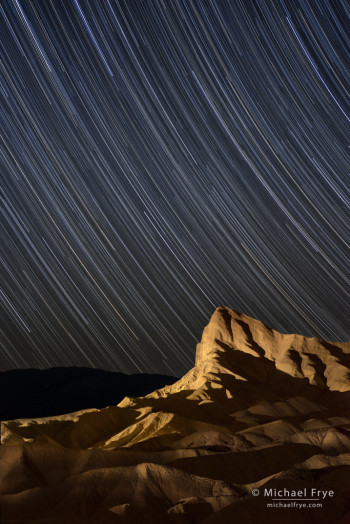
Manly Beacon at night with star trails, Death Valley NP, CA, USA
Manly Beacon is Death Valley’s most iconic feature, seen in millions of photographs from Zabriskie Point, including the image on the cover of the park map and brochure. So naturally I thought it would be fun to light it up at night.
One evening during our recent trip to Death Valley, Claudia and I, accompanied by our friend Robert Eckhardt, started down the Golden Canyon Trail from Zabriskie Point, carrying my powerful (3200 lumens), battery-powered spotlight, and radios for communication. Robert and I wanted a lower vantage point where the Beacon would poke up into the sky, and found a perfect spot. We set up our cameras and made some dusk exposures. Then after dark I hiked about half a mile further down the trail, carrying the spotlight and a radio, to a location I thought would work for the light-painting. Claudia acted as radio operator, and Robert tripped the shutters on both our cameras, while I used the spotlight to illuminate the Beacon.
We took a guess at the exposure, initially leaving the shutters open for 30 seconds at f/4, with the ISO set to 2500. According to Claudia and Robert’s radio reports, this exposure – surprisingly – turned out to be perfect. It did take several tries to get the lighting balance just right, but the problem was that the ridges underneath the Beacon weren’t getting lit from this spot. So I climbed back up the trail to a different location, closer to the cameras, which proved to be perfect for lighting those foreground ridges.
(more…)
by Michael Frye | May 3, 2015 | Night Photography
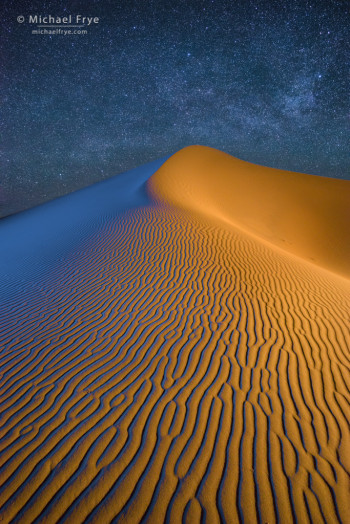
Sand dune and the Milky Way at night, Death Valley National Park
One night during our Death Valley workshop we went out to the sand dunes. After some searching, I found this wonderful dune with it’s rippled foreground textures. Lighting it was a group project; we all set up our cameras, and took turns lighting the dune from the left and the right, trying to find the right angles to highlight those ripples. Then we set our interval timers to record star trails – and took naps on the sand while we waited for the star-trail sequences to finish. After that the Milky Way was in the right position over the dune, so before moving our cameras we made some more exposures of pinpoint stars as well.
Recording all these exposures of the same composition gave us the option of including either star trails or pinpoint stars in the final image, and having the dune lit either from the left, the right, or both. I liked the pinpoint stars better, and chose to include lighting from both sides. The final image you see here is a composite of three exposures (assembled in Photoshop using the Lighten blending mode): one for the sky, one with the dune lit from the left (colored blue), and one with the dune lit from the right.
(more…)
by Michael Frye | Apr 24, 2015 | Composition
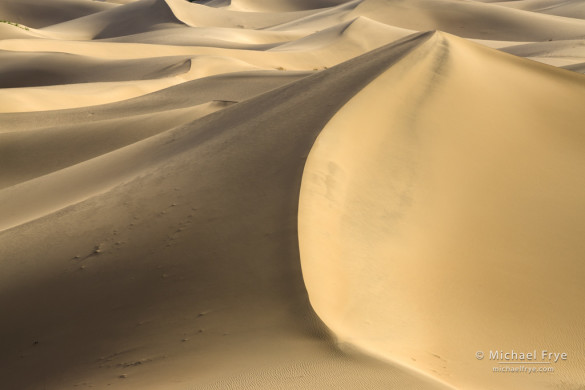
Peaks and curves
Claudia and I just finished a night photography workshop in Death Valley and the Trona Pinnacles with our good friend and assistant Robert Eckhardt. It was so much fun, with a great group of people in some wonderful places.
We made plenty of nighttime photographs of course, but we also got to spend two mornings in the Mesquite Flat dunes in Death Valley, once while scouting before the workshop, and the second time with the group. Both of these visits followed big wind storms the day before, and the dunes were pristine, with no footprints.
(more…)
by Michael Frye | Dec 30, 2014 | Announcements
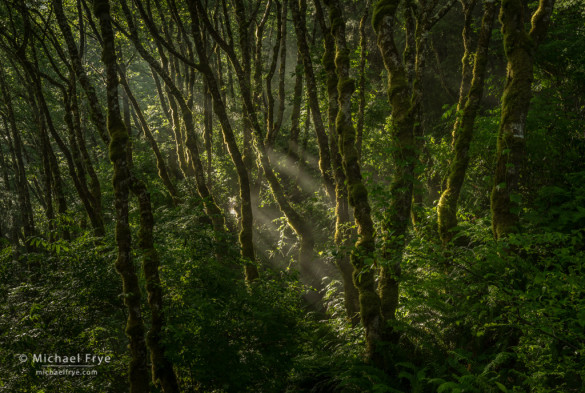
Alders and sunbeams, Redwood NP. My most popular post in 2014 was a review of the Sony A7r, the camera used for this photo. The Sony sensor allowed me to capture great detail, and also lighten shadows without generating noise.
With the new year approaching, it seems like a good time to look back at my most popular posts from 2014:
Should Your Next Camera be a Sony?
I don’t talk about equipment very often, because more gear won’t make you a better photographer. But I felt compelled to test – and write about – the Sony A7r because Canon has been so slow to make improvements to their full-frame sensors, and the A7r offers a higher-resolution, low-noise body that can be used with Canon lenses. Plus it’s a mirrorless camera, and I wanted to see if an electronic viewfinder could work for serious landscape photography.
(more…)
by Michael Frye | Sep 7, 2014 | Night Photography
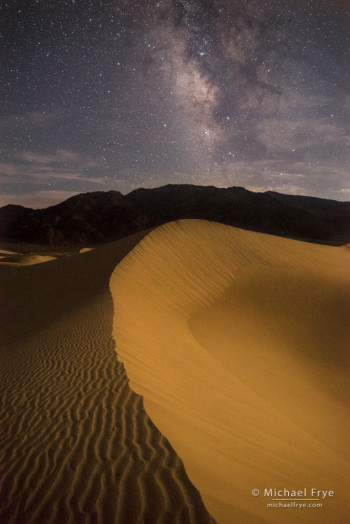
Moonlit sand dunes and the Milky Way, Death Valley. This is the photograph I originally envisioned from Death Valley, with dunes lit by the setting moon and the Milky Way above. (20 sec. at f/2.8, 6400 ISO)
Where do you go to escape the crowds on Labor Day weekend? How about Death Valley, where the temperature was forecast to be 112 degrees! That should keep the tourists away.
Okay, escaping the crowds wasn’t really the motivation for going to Death Valley in August. I had an idea for making a photograph with low-angle moonlight illuminating the sand dunes, and the Milky Way above. The moon had to be in the right phase: too much moonlight and the sky would become washed out, obscuring the Milky Way and most of the stars; too little and you wouldn’t see the effect of the moonlight on the dunes.
The moon also had to be far enough from the Milky Way to keep the moon itself out of the photograph, as it would be impossible to properly expose both the moon and the landscape in the same frame. The moon also needed to be close to the horizon, and off to the side (with the camera pointed at the Milky Way), as that low-angle sidelight would emphasize the form and texture of the dunes.
Not long ago I wrote about two apps for forecasting the position of the Milky Way and moon, PhotoPills and Star Walk. Consulting both of these apps I had figured out that the moon and Milky Way would be in the right position for the photograph I had in mind on the Friday and Saturday before Labor Day. And the next time the moon and Milky Way would be in a good position for this would be… next April, or even May. I decided to brave the heat rather than wait.
I had initially planned to go to Death Valley on Friday, but a thick bank of high clouds moved in – the remnants of Tropical Storm Marie. Since the skies looked clearer further south, Claudia and I kept driving and headed for the Trona Pinnacles.
(more…)













